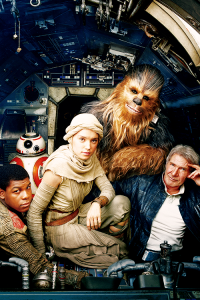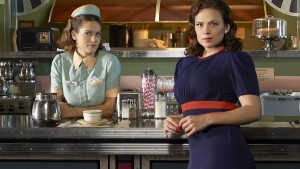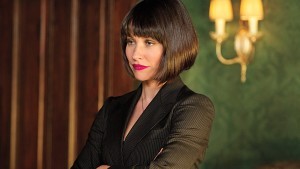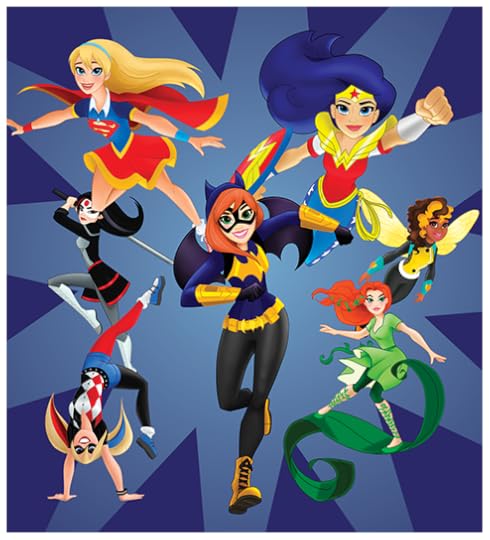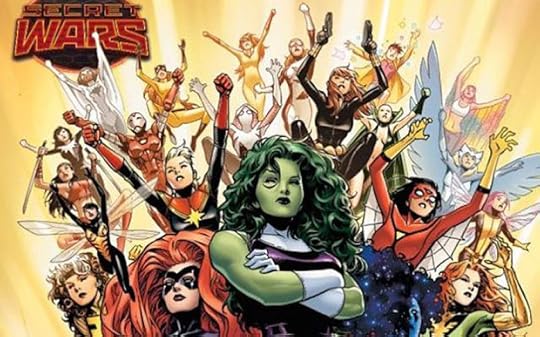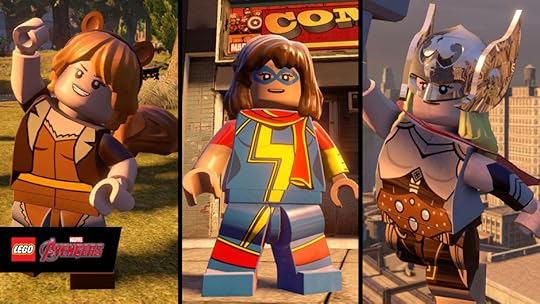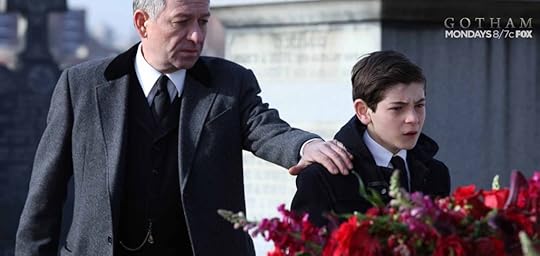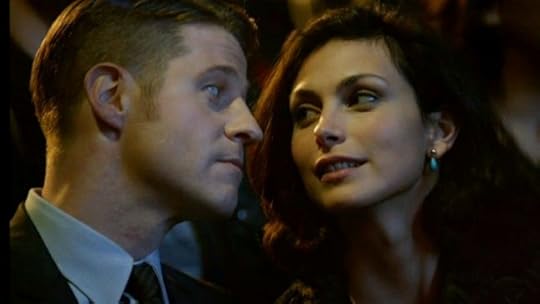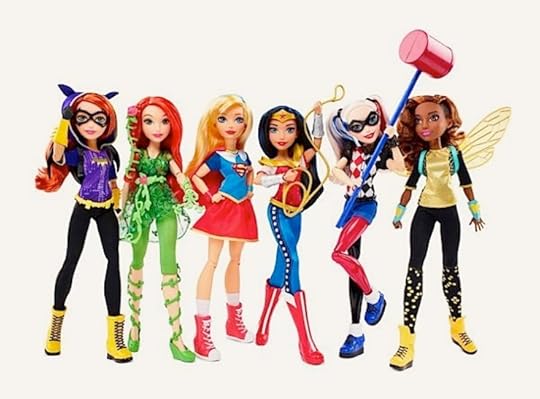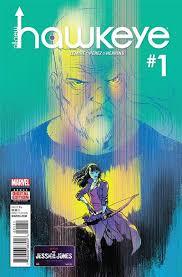Tansy Rayner Roberts's Blog, page 33
January 5, 2016
Star Wars: the Force Awakens Spoilerific
We went, we watched, and now we’re going to flail our hands about it, shortly before going to buy all the Rey toys that aren’t out there.
Get the episode here or on iTunes!
Relevant Links:
The Bechdel-Wallace Test – is this film feminist?
What To Do When You’re Not the Hero Any More
John Boyega being super excited about being in Star Wars
Lupita Nyong’o on not being seen as herself in Star Wars
Emo Kylo Ren
#WheresRey
Skype number: 03 90164171 (within Australia) +613 90164171 (from overseas)
Please send feedback to us at galacticsuburbia@gmail.com, follow us on Twitter at @galacticsuburbs, check out Galactic Suburbia Podcast on Facebook, support us at Patreon (http://www.patreon.com/galacticsuburbia) and don’t forget to leave a review on iTunes if you love us!
January 1, 2016
In Your Face, Cleopatra
Another year, another successful Aussie crowdfunding campaign!
Tehani put up the Pozible campaign on New Year’s Day to gather pre-orders for her upcoming anthology, In Your Face, and it filled its target within the first 12 hours. Hooray! You can still go and pre-purchase your copy of the book, due out by Easter I believe, with some special early bird pledging options.
The anthology is intended to be a showcase of Australian SFF that deals with confronting/provocative themes. When Tehani invited me to submit, I couldn’t think of anything I had ready to go which would be ‘in your face’ enough… in fact, since I’ve had so little time to write on spec for the last few years, I didn’t have anything at all. Except for, you know, this domestic violence piece I wrote that I never intended to submit at all…
Oh, well, that. I have to say, it’s the fastest turnaround I’ve ever had between ‘I have nothing’ to ‘I have maybe something, what do you think?’ and ‘STORY ACCEPTED.’
“Letters to Cleopatra” is a story I wrote for myself, as a coda (or an introduction, I haven’t decided yet) to a book I’m not ready to publish yet. I’ve been thinking for a long time about creating a collection of stories based on Ovid’s Heroides, which is a classical text close to my heart because it’s about the closest thing we have to feminism in the ancient world: a book of poems written in the form of letters from women of Greek mythology, addressed to the men who have done them wrong – and calling attention to the misogyny embedded in so many heroic tales.
Yeah, Ovid was pretty great. There’s a fantastic new translation of the Heroides by Clare Pollard which got me extra excited by my project.
So far I’ve written two full length stories that can be part of this maybe-future collection: “The Minotaur Girls” my gender-swapped 1980’s teen rollerskating Ariadne and Theseus story which I wrote for Glitter and Mayhem, and “The Love Letters of Swans,” my Paris and Helen shapechanger story (I have so many FEELINGS about Paris and Helen you can’t even imagine) which was published in Fablecroft’s Phantazein. I have a list of other stories a mile long, including an “Atalanta and Media BFFs forever” story and one about 1930’s spinsters, and a version of Phaedra and Hippolytus set behind the scenes of a glam soap opera, and, and, and…
“Letters to Cleopatra” came out of this, a dark savage little story about writing letters to imaginary heroes, and the way that teenage girls are held up as figures of mockery in our society, and the invisibility of domestic violence in Australia. Someday it will be a coda to my book about Desperate Heroines, but until then, it has found a home of its own at In Your Face, alongside stories I can’t wait to read and the reprint of Paul Haines’ classic, devastating novella “Wives.”
Order your copy of In Your Face now!
December 29, 2015
Issue #1: All-New, All-Different Avengers
 Title: All-New, All-Different Avengers #1
Title: All-New, All-Different Avengers #1
Writer: Mark Waid
Artist: Adam Kubert & Mahmud Asrar
The Buzz: This one’s been telegraphed for a long time, as a genuinely diverse version of the Avengers that still acknowledges the legacy and history of the team.
All You Need To Know: Tony Stark/Iron Man, Sam Wilson/Captain America, Kamala Khan/Ms Marvel, Jane Foster/Thor, etc.
Story: An actual ‘how the gang got together’ storyline for a team book! Amazing! Also, a Sam Wilson/Captain America storyline in which he isn’t a raging asshole, also amazing.
We get two mini-stories in this first issue, as the coming together of the team is obviously going to form the first arc rather than being taken as read. (I appreciate this so much) The first story shows how Sam Wilson’s captaincy means he is constantly having to deal with racial politics and representation in the public sphere – and how exhausting that can be. Tony Stark, meanwhile, is going through a rebuilding period after a long time away. The two of them team up with Spidey (Miles Morales) to investigate some alieny-explosions, while discussing the fact that there isn’t actually a proper Avengers team right now.
I liked their interactions a lot, but was startled when this story ended so quickly, and prepared to be really cranky that the first issue centred around three blokes. Then the second story came along! This piece, about the terrible impression Nova made on Ms Marvel when he first met her, is a fun introduction to both characters and their personalities. I liked the way that they had very different voices in their heads to what they managed to say out loud, and there was a solid understanding of how a teenage boy and a teenage girl read certain situations very differently – from revealing your secret identity (too soon, dude) to following someone down a dark alley.
All in all this issue is like 80% characterisation to 20% plot and action, which is exactly how I like my comics (and my team books in particular). It reminds me a little of the old Justice League Quarterlys, which are my favourite anthology books, though I have no idea whether the anthology style will continue once the comic finds its feet.
Art: Two different artists on this one, and I like them both despite their different styles. Adam Kuberts is the kind of clean lined, bright coloured, good character faces art that I like as a default, though I can’t really tell whether he’s an artist for me until he gets a story with some women in it. Asrar’s artwork has more of a pencil sketch style, but I liked it a lot and it suits the Ms Marvel I’ve seen so far in her own comic.
But What Did I Miss?: Thanks to the crazy antics of Secret Wars, Battleworld etc., and me being behind on a bunch of books, I have no idea what’s been going on with these characters. This is a good introducey sort of book, if you’re in the same boat. It actually feels like the beginning of a new era of Avengers instead of being yet another ‘you walked into the middle of something’ fake issue 1.
Would Read Issue 2?: Yep, I’m intrigued.
Read it if you Like: Ms Marvel, various animated shows featuring the Avengers or Spider-Man, that sort of thing.
Previously reviewed this year:
Thor #1 (2014)
Spider-Woman #1 (2014)
All-New Captain America #1 (2014)
Captain America & the Mighty Avengers #1 (2014)
S.H.I.E.L.D. #1 (2014)
The Unbeatable Squirrel Girl #1 (2015)
Bitch Planet #1 (2014)
Secret Six #1 (2014)
Operation: S.I.N. #1
Spider-Gwen #1
Curb Stomp #1
Jem & the Holograms #1
Silk #1
Issue #1 – Convergence Special – Oracle, JLI, Batgirl
Issue #1 – Battleworld Special: Lady Kate, Ms America & Inferno
X-Men ’92 #1
Giant-Sized Little Marvels: AvX #1 (2015)
Runaways #1 (2015)
Loki, Agent of Asgard #1 (2014)
Fresh Romance #1
All-New Hawkeye #1
Black Canary #1
The Wicked and the Divine #1 (2014)
Bombshells #1
Captain Marvel & the Carol Corps #1
50 Years of SHIELD: Mockingbird #1
50 Years of SHIELD: (Don’t Call Her…) The Cavalry #1
50 Years of SHIELD: Quake #1
50 Years of SHIELD: Fury #1
50 Years of SHIELD: Agent Carter #1
New Avengers #1 (2015)
Totally Awesome Hulk #1
All-New Hawkeye #1
Spider-Woman #1 (2014)
December 28, 2015
Superwomen of the Year
 2015 was a really good year for female superheroes on screen. The rise of the superhero genre in cinema over the last 15 years, and the momentum of that success, from the X-Men through the Grimdark Batmans to the dominating force of the Marvel Cinematic Universe, has been dogged with a lot of… well, problematic gender issues.
2015 was a really good year for female superheroes on screen. The rise of the superhero genre in cinema over the last 15 years, and the momentum of that success, from the X-Men through the Grimdark Batmans to the dominating force of the Marvel Cinematic Universe, has been dogged with a lot of… well, problematic gender issues.
Let’s be clear here, problematic gender issues have always gone hand in hand with the superhero genre, no matter the medium. A lot of the ‘ow, just got punched in the face’ gender problems of cinematic or TV adaptations from the comics are reproduced directly from the original source material – and it doesn’t help that while comics themselves have been developing new, diverse and interesting modes of storytelling that are far more inclusive of women, people of colour, alternative sexualities etc, the media adaptations often reach first for the original, very white, very male-centred versions of the stories.
(The only second generation super hero to make it to the Marvel Cinematic Universe in a ‘first’ movie, for example, was Paul Rudd’s Scott Lang/Ant-Man who was amiable enough, but so generic a character that I kept mistaking him for Chris Pratt whenever he put the mask on)
Still, we can’t blame it all on Seventies Stan Lee. Hollywood and TV production being what it is, modern media has a way of punching female audiences in the face in new, interesting and entirely canon-non-compatible ways. Women get fridged in new and interesting ways. The Phoenix Saga ends with Jean Grey’s sacrifice being 99% about Wolverine, because Hugh Jackman is the breakout star of those movies. Rogue’s storyline is literally excised from the most recent X-Men movie, even though there are enough fans to justify releasing a secondary DVD that still includes her. Gritty Batman Trilogy creates an original love interest only to horribly murder her in order to accentuate Bruce Wayne’s Man Pain. The first seasons of the TV adaptations of The Arrow and the Flash go to extraordinary lengths to prevent Laurel Lance and Iris West being useful, trustworthy or likeable, because future love interests don’t have to be real people. The plot of Ant-Man actually revolves around the way that women are overlooked in superhero stories. Gamora gets called a whore, in a line that contradicts the established characterisation of Drax, in order to get a cheap laugh.
Ahem. But. But. In all this, with all the problems, the movie and TV adaptations have managed to bring some iconic and legendary figures to the screen. And… it does feel like it’s getting better. If progress has been made in this pop culture battle about treating female characters with respect, then it feels like it happened in 2015.
There’s been a lot of talk about Supergirl and Jessica Jones, and what the success of these two shows says about the changing, improving portrayal of women in superhero narratives.
You can read my many Jessica Jones posts on Tor.com:
The Alias Reread Masterlist
Jessica Jones Does Not Respect Doors (1-2)
Jessica Jones Can’t Have Nice Things (3)
The Jessica Jones Paranoid Conspiracy Support Group (4-5)
Jessica Is Her Own Worst Enemy (6)
Jessica Jones Wants You To Do The Hero Thing (7-8)
Jessica Jones Takes Control (9-10)
Patsy’s Gonna Save You, Jessica Jones (11)
Jessica Jones is Uniquely Qualified (12-13)
But not only do we not have to choose between Supergirl or Jessica as embodiments of super-powered women, we also should acknowledge that these shows emerged in the latter part of a year that was already rich with female superhero narratives.
Not perfect, and not dominated, but rich. Having so many different media versions of the female superhero is such a relief, because it allows for a variety of different archetypes. We can stop asking, where are all the superwomen? They’re here, and their shows/movies are successful, and that means we can have more later.
So before we forget that Supergirl and Jessica Jones weren’t the only women with superhero narratives this year, check out all the others that filled our screens in 2015:
Read my original essay, Reasons To Love Agent Carter.
The fact that this series exists at all is a testament to the loyalty of fans, and the audience’s desire to find stories that celebrate female heroes. Peggy Carter was the feisty love interest in Captain America, designed to be left behind in a tragic separation. But she wouldn’t lie down – the strength of the character and Hayley Atwell’s charming performance cemented her as a fan favourite, and she not only got her own short film but also appearances in other Marvel properties, like Agents of SHIELD and Ant-Man.
Agent Carter, chased through it was by assumptions and declarations that the audience was too small and the show needed to be “saved” despite having pretty good ratings, was a fantastic drama series with tons of appeal to those outside the usual cabal of superhero fans – a historical post-war spy show with gorgeous period setting and costumes, a sly sense of humour, and overt feminist commentary.
Peggy is a pragmatic, fierce character who fights like a bruiser, dresses like a lay-dee and has a snarky line for every occasion. More to the point, while her friendships with men such as Howard Stark, Dum Dum Dugan and Jarvis are fun to watch, as are her more fractious relationships with her male workmates, she’s not one of those female heroes who is presented as oh so special because she’s the only woman in the story. Peggy befriends women (her friendship with Angie Martinelli is the key relationship of the show), lives in an adorable all-female boarding house, and has a magnificent female nemesis who is (it is implied) a predecessor of the Black Widow.
Speaking of which…
Yeah, you know what, Black Widow was handled in some problematic ways in this movie. I’m in two minds about the Bruce-Natasha romance, as I was happy to ship them before I saw the movie but the actual script let them down, largely because there wasn’t time to portray a credible semi-doomed romance in the three and a half scenes they were allowed.
Only one of those scenes (the controversial “monster” conversation) was truly terrible – I personally enjoyed the flirting over cocktails and the excellent “I adore you but I need the other guy” sequence. I disliked a lot of choices for her character here – showing Natasha’s sterilisation as a character defining moment equal to her murdering people as a teenager mixed the message A LOT, and again is too big to handle as a minor team movie subplot. The line about ‘picking up after you boys’ as part of her epic motorbike sequence was grossly sexist and felt out of character (then insult added to injury when the toy of this sequence removed her entirely, though it would have actually great if Captain America was the one who said the line about picking up after the other heroes, you know he’s the only one who knows how to wash dishes), and I really didn’t like that the iconic spy character was locked in a dungeon and had to be rescued by her non-powered boyfriend rather than, you know, picking a damned lock.
On the other hand, Scarlett Johanssen is able to elevate even the most banal dialogue, and she has some powerful moments in this film outside of the no-mance – her amused refusal to play the macho game of who can lift Mjolnir, for example, and her deep friendship with Hawkeye and Laura. Fandom has been assuming for a long time that Clint and Nat were BFFs and I loved that their best friends status was confirmed in this movie.
Yeah, they’re straws, but I choose to grasp them. She gets to be directed by the Russo brothers again in the next movie, we’ll get our Natasha back.
Meanwhile, Age of Ultron gave us a thoroughly 21st century version of Scarlet Witch, longtime winner of the Silliest Costume in the Marvel Universe contest. Played by Elizabeth Olsen, she is presented a fierce and vulnerable young woman coming into her powers and charged by personal demons. Removed from her status a pawn in the Magneto angst story of the comics, her relationship with her brother and their desperation for survival comes across as authentic and compelling.
I’m really cross that there hasn’t been more of an effort to promote this Scarlet Witch as a toy and character for young girls to follow – the lack of girl friendly merch for the Avengers is constantly annoying to me (Where’s Rey is an important question to ask but I’ve been pushing Where’s Wanda all year!). Wanda is amazing and deserves more recognition as an iconic character with a lot to offer the Marvel Universe.
Speaking of which, more Maria Hill in everything, please.
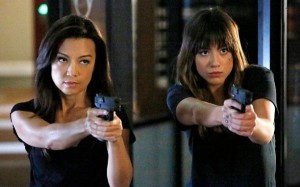 AGENTS OF SHIELD
AGENTS OF SHIELD
While a lot of the chatter around this show is about the ever-fan-worshipped Coulson and boring bad boy Ward, it’s also been sneakily presenting some of the most complex, interesting and butt-kicking women of the Marvel Cinematic Universe. For years. The second half of Season 2, screening earlier in2015, gave us not only more Melinda May (who is the best of everything), but revolved around a mother-daughter hero-villain dynamic, exploring superheroics, alienation and family relationships with newly-minted Inhuman Skye/Daisy and her sinister mother Jiaying. Over the same season, Skye’s surrogate daughter relationship with Coulson was balanced out by a mentor relationship with May.
The tiresome exes-who-love-each-other-truly relationship between Bobbi Morse (Mockingbird) and Lance Hunter also resolved in a really interesting way in the season finale – Bobbi, the more hardened and experienced agent, has been given the more traditionally masculine flaws in their relationship, embodying the tough love, logical commitment-phobe while Hunter hoards all the squishy feelings. This comes to a head beautifully in the final episode when she is abducted and tortured, but is still framed as the hero who has to make the hard choices, instead of the damsel to be rescued – ultimately, she chooses to take a bullet for him in a seriously hardcore scene, when he thinks he is rescuing her.
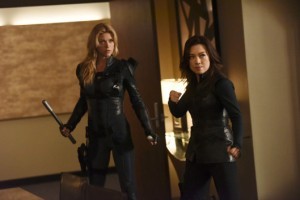 In the first half of Season 3, it’s Jemma Simmons’ (cutesy scientist girl) turn to be a badass when she is transported to an alien world and has to find her inner survivalist. Skye, meanwhile, has levelled up between seasons to become a full on agent-with-superpowers, reclaiming her identity as Daisy Johnson (it’s significant that only Coulson, her paternal boss figure, has problems remembering the name change). May is still amazing, dealing with all kinds of family crap on top of a crisis of faith in her own abilities (which doesn’t stop her doing her damn job and helping her friends). Bobbi has to deal with some fairly realistic physical therapy, plus filling in for the absent Simmons, which means she gets to get more in touch with her scientist side (the character is a trained biochemist as well as a spy).
In the first half of Season 3, it’s Jemma Simmons’ (cutesy scientist girl) turn to be a badass when she is transported to an alien world and has to find her inner survivalist. Skye, meanwhile, has levelled up between seasons to become a full on agent-with-superpowers, reclaiming her identity as Daisy Johnson (it’s significant that only Coulson, her paternal boss figure, has problems remembering the name change). May is still amazing, dealing with all kinds of family crap on top of a crisis of faith in her own abilities (which doesn’t stop her doing her damn job and helping her friends). Bobbi has to deal with some fairly realistic physical therapy, plus filling in for the absent Simmons, which means she gets to get more in touch with her scientist side (the character is a trained biochemist as well as a spy).
All in all, this is a show full of interesting, engaged and active female characters who blur the lines between spies, scientists and superheroes. Even when it’s terrible (and it does have its terrible moments) we still have that.
Yeah, the best things that this movie does as far as female superheroes are concerned are not actually in the movie. Janet’s history as the Wasp, and her daughter Hope’s future as the Wasp, will hopefully both be addressed in the sequel, but right now it’s all wind and promise. Evangeline Lilly does a great job of portraying the frustration at her character being deliberately kept from using her skills because her father has issues. The audience shares her frustration. Also, the kid who plays Cassie gives me hope that we’ll get a Young Avengers in about 8 years time. That’s about it.
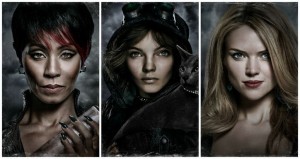 GOTHAM
GOTHAM
As I wrote elsewhere this month, Gotham is full of old-fashioned, lady-strangling noir tropes, far from being the modern take on the genre that we get from Jessica Jones or even Agents of SHIELD – but it does provide a fantastic, non-sexualised teen version of Selina Kyle/Catwoman, and a vivid, powerful original female villain/antagonist in Jada Pinkett-Smith’s Fish Mooney in Season 1. Season 2 continues in this vein, with some horrid violence against women, but also some very lively and entertaining female villains. Selina is still the best, and I’m presuming/hoping her iconic future makes her less likely to be murdered. DAREDEVIL
DAREDEVIL
This is not a show of female empowerment either – it is pure, unadulterated toxic masculinity (albeit with ironic commentary on the same), though I was impressed by it as a piece of drama. I did very much like the writing of Karen Page, a supporting character who has been treated abominably in the comics. The writing skirted very carefully around some of the more problematic ‘dark past’ aspects of Karen, portraying her as a smart, brave if traumatised woman who survives a horrific experience (being framed for the murder of a colleague) and recovers through her new friendship with Matt and Foggy. (also I’m pretty sure her friendship with Mrs Cardenas is the only reason the show passes the Bechdel Test though I can’t be sure of that because my Netflix won’t show me subtitles which is a cause of great ongoing misery to me) Even the fact that Karen isn’t in on the Daredevil secret yet is portrayed in a way that makes sense, and she has a terrible secret of her own to balance that out.
Which brings me to…
I liked the first season of The Flash a lot, but it had one flaw, which grew more and more enraging as the season went on. Iris West is, in the original comics, Barry’s love interest, girlfriend and future wife – a girl reporter in the vein of Lois Lane. In the show, she’s portrayed as his foster-sister (ew) whom he has an unrequited crush on (EW). Even more uncomfortably, her father, Joe (Barry Allen has three Dads in this show, Earnest Prison Dad, Evil Scientist Dad, and Joe West, his foster father AKA Best Dad) is an amazing supportive father to Barry while being a terrible, patronising and utter fail of an over-protective father to Iris. Worst of all, he totally ships Barry and Iris, active sabotating her relationship with his cop partner Eddie while trying to push the foster siblings together.
Honestly, the show is really good except for this part which had me literally screaming at the screen at times.
Iris takes on the Laurel Lance position of “future love interest who can’t be trusted to understand the premise of the show” and thus the whole first season revolves around the secrets that Barry, his friends, and Best Dad, all keep from her, apparently for her own good. Even though she keeps putting herself in danger because of the deliberate ignorance they perpetuate in her.
BUT.
There had to be a but, right?
Finally, toward the end of the season, Iris discovered the truth, and the change in the show’s respect for her was shockingly quick. Suddenly she was a useful, active member of Barry’s support group. She got to be smart and sarcastic and actually contribute to the story. Literally the first adventure after the reveal involved her Dad being damsell’d and Iris integrating into the gang. About bloody time.
I am not properly caught up on the new season of the Flash but from what I’ve seen, Iris is greatly improved as a character now she’s in the gang, and even allowed to have friendly interactions with other women. Gasp! Also I’ve been promised Dr Light, who is one of my all time favourites, so I’m excited to see where it goes. But oh, trope about deliberately keeping women in ignorance to “protect them” please die out now and forever.
Arrow is one of those shows best watched with a group of friends joining in with shrieks of outrage and chatting during the boring flashbacks. It’s silly, campy but at times genuinely awesome. My relationship with it is complicated.
With a two year lead over The Flash, Arrow’s central problem (apart from their woeful understanding of how interesting flashbacks are likely to be when you do them every single week) has always been Laurel Lance. Set up at the beginning as Ollie’s wronged ex-girlfriend, Laurel suffered from being kept out of the superhero storyline for far too long, despite being supposedly based on classic character Black Canary. (She had no personality or background elements in common with the original, except for having a familial connection to a police detective)
She also suffered because the hero had far more chemistry with Felicity, the quirky computer support person, and the show followed through with that relationship gleefully. While Felicity was invited to join the gang in the Arrow cave, Laurel spiralled into self-destruction because the scriptwriters could not think of anything else to do with her. To add insult to injury, they brought back her sister from the dead, who had all the hallmarks of being, well. Black Canary.
 Finally, in Season 3, Laurel got a chance to come into her own. Mourning her sister and finally allowed in on the big secret that Ollie was a street vigilante, she began to develop her own storyline, taking on the Canary character, training independently with Wildcat (happy sigh), and refusing to let either her father or Ollie define her road to being a hero. (sadly she was also hamstrung by a ridiculously awful ‘don’t tell Dad his other daughter is dead’ subplot because the rule of Arrow is that Laurel can’t have nice things)
Finally, in Season 3, Laurel got a chance to come into her own. Mourning her sister and finally allowed in on the big secret that Ollie was a street vigilante, she began to develop her own storyline, taking on the Canary character, training independently with Wildcat (happy sigh), and refusing to let either her father or Ollie define her road to being a hero. (sadly she was also hamstrung by a ridiculously awful ‘don’t tell Dad his other daughter is dead’ subplot because the rule of Arrow is that Laurel can’t have nice things)
In 2015, with the stupid secrets all finally abandoned in favour of less patronising storylines, Laurel transitioned into a mostly credible Black Canary – hey, she still doesn’t have a sense of humour, but at least she looks the part, and Katie Cassidy has proved to be (finally, finally) a fantastic advocate for Black Canary being awesome.
Meanwhile, the other female character who was kept in the dark for several years – Oliver’s sister Thea – got to not only train in secret to be her own special kind of kickass, but got to vocalise what viewers (mostly me) have been howling about for years – telling the people in your life that you are secretly a street vigilante does not actually make them LESS SAFE. Information is not nearly as dangerous as oblivion.
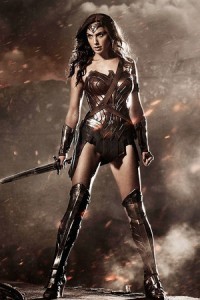 THE GHOSTS OF FUTURE DC FILMS
THE GHOSTS OF FUTURE DC FILMS
Wonder Woman has been promised all over 2015 – with hints of her role in the upcoming Superman vs Batman: Two Parts Of This Trinity Have Dicks. Gal Godot looks the part, but I don’t think anyone has high hopes of her getting to do much in that movie.
More promising are the hints of the Wonder Woman solo movie on its way, with articles about the women behind the scenes, casting news that suggests lots of female roles, and oh it’s a prequel to the Superman Justifies Mass Property Damage To Batman film which means that we can retroactively pretend that appearance didn’t happen if we need to!
There’s also been rumblings that we may be getting a Black Canary in the impending Justice League movie, as a stepping stone to a Birds of Prey movie. Hooray! More than one woman on the team in the first Justice League movie? YES PLEASE.
In post-Crisis comics continuity, Black Canary replaced Wonder Woman as the token First Lady of the Justice League… though before that, she was part of the ensemble cast including both superheroes, plus Hawkgirl and Zatanna and others. The Avengers made a terrible misstep in only allowing one woman to launch the team (which puts so much pressure on Black Widow to be perfect, flawless feminist icon), so I really hope Justice League has a more balanced team.
2015 was a great year of the Female Superhero – but 2016 is (I hope) going to be pretty damned good too. Maybe we won’t get another season of Jessica Jones (yet) but we have been promised Agent Carter in Hollywood, White Canary and Hawkgirl in Legends of Tomorrow, a full season pickup for Supergirl, more Gotham, more Black Canary, more Iris West and Daisy Johnson and Melinda May and Bobbi Morse and Jemma Simmons…
Oh, and the next Netflix Original might be called Luke Cage, but it’s bringing Misty Knight into the Marvel Cinematic Universe, while Daredevil Season 2 promises Elektra.
Finally, the superhero genre in television and film is catching up with the rest of us. The Captain Marvel film is a mirage that keeps disappearing into the horizon, but in the meantime there is a lot to be cheerful about.
December 16, 2015
Gotham’s Women
 SPOILERS for Season 1 of Gotham (not a lot of spoilers, mostly character arc stuff, almost no plot), hardly any mention of Season 2.
SPOILERS for Season 1 of Gotham (not a lot of spoilers, mostly character arc stuff, almost no plot), hardly any mention of Season 2.
I wasn’t sure what to make of Gotham when the show was first announced – a prequel to Batman? A story about all the characters of one of the 20th century’s most complex pop culture mythologies, before they got interesting? A pre-origin story in an era that has made us thoroughly sick of superhero origin stories? Bah.
So basically I was an idiot.
Gotham is an extraordinary piece of drama – and it deserves to sit alongside Agent Carter, Daredevil and Jessica Jones as examples of TV shows that use the meat of superhero comics while not conforming to the superhero genre. Gotham is a crime drama and mobster tragedy, set in a fascinating city that meshes 1940’s noir with 21st century technology – they all have cell phones, but the men wear hats.
It’s very much a love song to masculinity: Jim Gordon (a compellingly stoic Ben McKenzie) is the new cop with a chip on his shoulder, trying so desperately to be a Good Man in a city where police and government corruption are so thick you can’t see through it. He’s partnered with Harvey Bullock (Donal Logue), who took his Good Man hat off a long time ago, and now comfortably wallows in the moral turpitude of Gotham’s dirty cop culture. Harvey is awful but hilarious and compelling if you can get past the awful to be entertained – think Gene Wolfe in Life on Mars.
You need a certain level of Stockholm Syndrome to properly enjoy this show, but once you’re there, it’s pretty great.
Then there’s baby Bruce Wayne (David Mazouz), a shell-shocked orphan from a family of immense privilege. The death of his parents (one of the most iconic murders in the DC universe) is the homicide investigation that kicks off the show, and Gordon’s struggle to find justice for the killer is a metaphor for how bad the city has already got. Rather than Batman being the impetus for some of the kookier crimes of Gotham City (a reading on the material that Tim Burton promoted and has often been taken as fact in later adaptations) it is clearly the death of Thomas and Martha Wayne, two figures representing the hope for progress and development in the city, which sends Gotham spiralling into a haze of psycho killers, deranged mobsters and Deep Weird.
Though to be honest, the city was already in bad shape when we got to it. There are so many shades of the epic dark arc of No Man’s Land in Gotham – you can totally see how, twenty years or so in the future, the city could get to the point that the bridges get blown and they create their own post-apocalyptic wasteland.
I assumed Bruce’s journey would be the least interesting one, like Bran in Game of Thrones, but the writing in this show is so tight and clever that every episode shows the development of the personality of the future Bruce Wayne and Batman – everything from his baby steps into investigative work, his growing philosophy on whether the means justifies the end with murder, his disillusionment with his parents’ company and with the city’s attempts at justice… hell, there’s even one episode where he pretends to be flirting with girls to cover his real secret plans!
Other than the Gordon-Bullock dynamic, the most important relationship in the show is that of Bruce with his butler/guardian, Alfred (Sean Pertwee). Alfred quite obviously spent his youth in a Guy Richie movie or three – he’s a rough and tumble Cockney type (honestly, Americans, even in the 21st century you need more than a general British accent to be a butler, you’re supposed to act posh) and his struggle to keep Bruce safe (and someday: happy) while not quite being allowed to be his parent is horribly fascinating.
Then there’s Oswald Cobblepot, a junior mobster and rising psychopath trying to survive and become great, despite the fact that he waddles like a Penguin… and Edward Nygma, a super creepy forensic pathologist who has an obsession with riddles… and a little street girl called Ivy with a green thumb…
All this, plus the city is full of powerful male mobsters and their thugs, killers, criminals, dirty cops… so where are the women?
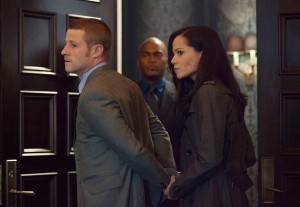 Make no mistake, this is a show which has a problem with women. It’s deeply sunk into gothic and noir tropes (not to mention being a crime drama in the world today) so we get a lot of dead and battered women on the screen, with many more being harassed, stalked or otherwise framed as victims. I wasn’t overly hopeful from the start, with Gordon’s established girlfriend Barbara Keen: a fragile, bitchy debutante with a drug problem; his boss Captain Essen, a pragmatic but largely ineffectual figurehead who does whatever her corrupt Commissioner decrees and condones the mobster influence over her men; and oh yes, let’s talk about Renee Montoya, who starts out strong as one of the only genuine Good Cops in the city – rightfully hounding Gordon when she thinks he has murdered a man – but descends quickly into the Evil Lesbian trope, stalking and hassling her ex-girlfriend Barbara until they finally fall back into bed together, after which we never see Renee again.
Make no mistake, this is a show which has a problem with women. It’s deeply sunk into gothic and noir tropes (not to mention being a crime drama in the world today) so we get a lot of dead and battered women on the screen, with many more being harassed, stalked or otherwise framed as victims. I wasn’t overly hopeful from the start, with Gordon’s established girlfriend Barbara Keen: a fragile, bitchy debutante with a drug problem; his boss Captain Essen, a pragmatic but largely ineffectual figurehead who does whatever her corrupt Commissioner decrees and condones the mobster influence over her men; and oh yes, let’s talk about Renee Montoya, who starts out strong as one of the only genuine Good Cops in the city – rightfully hounding Gordon when she thinks he has murdered a man – but descends quickly into the Evil Lesbian trope, stalking and hassling her ex-girlfriend Barbara until they finally fall back into bed together, after which we never see Renee again.
But. Despite the many gender problems inherent in Gotham, there are also some magnificent jewels of female characters who completely saved the show for me (or at least saved me from feeling guilty about enjoying all the bloke!drama so much).
Firstly, there is Fish Mooney. This original character is the only powerful women in the macho world of mobsters and crooked business tycoons. Played marvellously by Jada Pinkett-Smith, Fish is a dangerous and seductive bar owner, high up in the chain of subservience to Carmine Falcone, the top dog in the city. From the start, we see Fish’s ambition, her distaste for playing second fiddle to a mob lord beyond his prime, and her utter ruthlessness.
She doesn’t hesitate to use her gender as a weapon, but she also commentates on sexism quite clearly. My favourite is the fantastic scene late in the first season where a man in a position of power calls her babe deliberately, to bait her, then promises to stop… and does it one more time. Her vengeance is simply glorious.
While Fish is obviously there to set up Penguin’s story – he famously begins his career as the holder of her umbrella and survives her violent fury to rise and rise again through the ranks – she takes on a life of her own, all schemes and vicious manipulation. Even when she fails – and she does fail, spectacularly, she is not crushed. Instead, we see her raw survival skills when she is dumped into a bizarre subplot involving an island of prisoners intended to be used as organ donors… and armed with nothing but a smile and some very long fingernails, she snags the position of prison top dog within 48 hours, insinuates herself into the business behind the prison, and leads a spectacular escape.
The most meaningful statement about Fish’s power and ability, is the space left behind once she is out of the city. Penguin attempts to step into her position as second in command to Falcone, and the manager of her club (now renamed Oswald’s) but he struggles at every turn – the work she made seem effortless (backwards and in high heels) is genuinely difficult, and he only keeps his head above water because he has her former second in command, Butch, whispering in his ear. It’s a little depressing that Fish exists to further Penguin’s narrative and not the other way around, because the most unbelievable thing about their storyline is that Season 1 does not end with her shoe embedded bloodily in his throat.
 Then, there’s Selina Kyle. There are some characters in the show who simply don’t make sense with the future Batman mythology I have in my head – Renee Montoya was a massive disappointment, and I have no idea what they’re doing with Barbara, but I can’t see my Batgirl being born any time soon. (I keen waiting for Barbara to spring a fake pregnancy, like in Glee Season 1).
Then, there’s Selina Kyle. There are some characters in the show who simply don’t make sense with the future Batman mythology I have in my head – Renee Montoya was a massive disappointment, and I have no idea what they’re doing with Barbara, but I can’t see my Batgirl being born any time soon. (I keen waiting for Barbara to spring a fake pregnancy, like in Glee Season 1).
Selina, however, makes all kinds of sense. Played spectacularly by new actress Camren Bicondova, Selina is a street kid with sharp attitude and survival skills who exudes such sweet charm that I can see the future Catwoman coming to life.
Catwoman’s often been a problem on screen, as is often the case for characters who are seen as “sexy” in the comics – so nothing else about their characters makes it through an adaptation. She was fun in the 60’s TV show, regardless who was playing her (though the sexism of the era meant we never saw Catwoman fight credibly, she merely lounged back and licked her paws while her men did it for her). Both Michelle Pfeiffer and Halle Berry’s versions were made weirdly problematic by ignoring 99% of the source material, and having both be ordinary women killed and brought back to life after being licked by cats (why oh why would you think that was the bit of Batman Returns worth repeating?).
The closest to a satisfying screen Catwoman (apart from the great Batman animated version) was Anne Hathaway in the third Dark Knight movie, who I very much enjoyed because of the return to retro catburglar Selina rather than angry cat person Selina – and they came close, though I don’t think they quite met the mark, of making her a true opposite-equal to Batman, which is part of the enduring appeal of her character.
 Camren Bicondova, however, knocks it out of the park. She’s not Catwoman yet (her street name is the Cat), but we see shades of that future in every scene – her whole life has been moving her towards being that person in the future. Her developing friendship with Bruce is extraordinary because it doesn’t take away from the relationship they will/might have in the future (you can’t have Clark Kent and Lois Lane meeting as twelve year olds, it would be weird, but it works with these two). The seed of their future conflict is already planted – his commitment to justice and the rule of law, her willingness to be a criminal in order to survive, not to mention their vastly different social spheres and experience of the world – but they genuinely like each other, and they work brilliantly as a team.
Camren Bicondova, however, knocks it out of the park. She’s not Catwoman yet (her street name is the Cat), but we see shades of that future in every scene – her whole life has been moving her towards being that person in the future. Her developing friendship with Bruce is extraordinary because it doesn’t take away from the relationship they will/might have in the future (you can’t have Clark Kent and Lois Lane meeting as twelve year olds, it would be weird, but it works with these two). The seed of their future conflict is already planted – his commitment to justice and the rule of law, her willingness to be a criminal in order to survive, not to mention their vastly different social spheres and experience of the world – but they genuinely like each other, and they work brilliantly as a team.
Seriously, they break my heart, these two.
Selina also is at the heart of the rare depictions of female friendship in the show – apart from Fish’s slightly creepy maternal grooming of the streetwise Liza into a useful tool against Falcone, most of the scenes of women together happen between Selina and Ivy, and between Selina and Barbara (except for the super awkward Barbara-Lee showdown in the final episode).
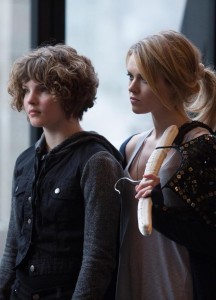 The Selina-Barbara dynamic is one of the weirdest things in a very weird show. I mean, what woman would accept two street kids squatting in her gorgeous clocktower penthouse, simply because they’re slightly acquainted with her cop ex boyfriend? But Barbara’s misery and her plummeting self-esteem after her break up with Jim Gordon and her disastrous reunion with Renee is such that she clings to her scrappy roommates and Selina in particular with surprising warmth.
The Selina-Barbara dynamic is one of the weirdest things in a very weird show. I mean, what woman would accept two street kids squatting in her gorgeous clocktower penthouse, simply because they’re slightly acquainted with her cop ex boyfriend? But Barbara’s misery and her plummeting self-esteem after her break up with Jim Gordon and her disastrous reunion with Renee is such that she clings to her scrappy roommates and Selina in particular with surprising warmth.
I mean, she doesn’t know how to talk to teenage girls other than to offer them makeovers, which is a brittle insight into her own teen years, but these scenes for all their awkwardness and occasional discomfort also show Barbara at her most vulnerable and likeable (Before, it has to be said, she descends into some fascinating dark places towards the end of the season, to be reframed as a villain rather than a broken damsel, which can only be a step up for her).
One scene has Barbara attempting to show Selina what a beautiful woman she is growing into, through fashion, only for Selina to reject her values sharply. This showed the contrast between the characters – and that Selina is well aware that growing up/looking beautiful is likely to cause her more trouble than it’s worth.
For the most part, Selina is not portrayed as a sexual object, which is a huge deal for the character of Catwoman, and was a huge relief to me as a viewer. She dresses for practicality and camouflage (with adorable goggles that prefigure one of her future costume designs) and we see her working to stay hidden, under the radar. Even when she does glam up, it’s in a party dress that emphasises her youth rather than making her look older, or in punk-gangster gear that is supposed to make her look scary-tough rather than sexy (it doesn’t, because she’s a kid, but it does make her look like a kid dressing up as a gangster which is all kinds of sad and adorable). Considering the age of the actress (14-15 when filming this season; the actor playing Bruce is 2 years younger) I really appreciate the careful line they tread with her.
In a city of misery, dark shadows and soul-rending corruption, Morena Baccarin’s Dr Leslie Thompkins is a breath of fresh air. After the miserable relationship he had with Barbara, it’s wonderful to see Jim Gordon embrace someone who actually has a positive attitude to life – and Lee is a wonder. She’s all about the adventure, she is competent and brave in the face of adversity and most importantly she’s the only person in this city (except maybe Harvey) who has a freaking sense of humour.
Jim is used to hiding the darker side of his work, because Barbara was pretty damned brittle and he didn’t trust her to be able to cope – but Lee is all in, to the point that she takes a job as the police medical examiner because police work fascinates her. She also calls Jim on his bullshit, and isn’t afraid of being honest about what she wants – at one point, he invites her to dinner and starts asking her advice on a case right away (because he’s nervous and doesn’t know how to talk to girls who aren’t manipulative debutantes). Lee tells him straight out that she put lipstick on for him, and is disappointed he asked her on what sounded like a date only to bring work into it… then, once he has apologised, she reaches for the files with glee, because solving crime is awesomecakes!
I love Lee so much. She’s like a slightly cuter version of Lois from Season 1 of Lois and Clark, (I know, right? CUTER) and is cut directly from the cloth of Rosalind Russell in His Girl Friday and other 1940’s Hollywood heroines – it’s like she wandered across the film lot from a screwball comedy and went: “Oh, noir, fun!” Lee is hard as nails when she has to be – I mean, she ran the female medical wing of Arkham Asylum, she’s not a wilting flower – and cool under pressure. She puts up with the city’s macho bullshit remarkably well. I’m excited she will be a main rather than recurring character in Season 2, with the caveat that I’m constantly terrified she’s gonna end up dead in a ditch. Every time they have looked like damselling her, however, she proves to be a capable survivor – and while she clearly is Jim’s weak spot, she’s not herself portrayed as weak. Fingers crossed that this continues.
Gotham does terrible things to women, but I caught some distinct gender progress over the season, and the stories got better for it. Fish’s entire season arc is glorious, I am deeply emotionally attached to both Selina and Leslie, and even Sarah Essen, Gordon’s ineffectual boss, begins to properly take charge and make some meaningful choices towards proper justice, as the guilt over what her cops have become starts to affect her. (Cough, since writing this I’ve watched a lot of Season 2 and… yes. Sigh. Selina and Leslie are still great, though!)
All this enough to assuage my personal feminist guilt that I find Harvey Bullock’s terrible behaviour utterly joyous (Stockholm Syndrome, I’m telling you), that it’s weirdly satisfying (if icky) to see the Penguin murder his way across the city, and that I actually care about teen Bruce Wayne’s personal journey.
Plus, you know, Sean Pertwee and his Cockney accent.
December 15, 2015
13. Thea Von Harbou & Metropolis [SF Women of the 20th Century]

Metropolis, the 1927 silent German expressionist film often held up as the first great science fiction movie (and currently viewable on Netflix) is generally credited as director Fritz Lang’s Metropolis, which was why I was so intrigued to discover the involvement (and extended career) of Thea Von Harbou, Lang’s wife and co-writer on the project.
Thea Von Harbou, a Bavarian aristocrat and child prodigy, was an active screenwriter, filmmaker, actress and novelist in Berlin between the first and second World Wars. She was married to Lang between 1922 and 1933.
Von Harbou’s writing technique often involved writing a novel and screenplay simultaneously or concurrently, so that the novel could be released at the same time as the film’s release – this was the case with Metropolis, in which she wrote the novel first (it was published in 1925 as a serial in the magazine Illustriertes Blatt well ahead of the film’s release, and then in novel form in 1926) but always intended the novel to promote the book rather than vice versa. Indeed, the serialised edition of the story was illustrated with set pictures of the film-in-progress. The intention was very much for the novel and the film to work in sympathy with each other, so that those confused by the film (given the limitations of how complex a story you could tell in the silent movie era) could get a deeper idea of the plot from the book – in the case of Metropolis the book became an essential tool for understanding the film after it was cut, re-edited and redistributed in later years, thanks to Lang’s unhappiness with the original version.
the super creepy original novel cover, featuring a still from the film
A great many magical and occult references were dropped from the screenplay (or, perhaps, expanded upon in the novel, as supernatural themes were of great interest to Von Harbou and often turned up in her work), though the film of Metropolis still holds a great deal of mythic and Biblical resonance, along with some quite extraordinary visual imagery.Metropolis depicts a future world where an elite aristocracy enjoy immense privilege, and a dehumanised underclass suffer as their workforce inside a factory system – near-literal cogs in a cruel machine. The film does not approve of this system – a great deal of the story is about demonstrating the unfairness of it – and yet it does not fully condemn/overthrow it either. The themes of man versus machine (and particularly, human workforce who are both treated as if they are machines, and ultimately replaced by machines) are highly relevant today – possibly even more so than when the film was released. The creation of a robot leads to a Frankenstein-style narrative, of a highly dangerous creation creating chaos, the main difference being that the central inhuman figure of Metropolis is female.
 Thea Von Harbou’s later work was often overtly nationalistic, with a focus on morale-boosting and sacrifice in the name of patriotism. She trod a careful and often uncomfortable political line as the Nazi Party took control of the state – several of her films of the era are overtly pro-Nazi, while she was also known to work (often uncredited) on other projects which were socialist in nature.
Thea Von Harbou’s later work was often overtly nationalistic, with a focus on morale-boosting and sacrifice in the name of patriotism. She trod a careful and often uncomfortable political line as the Nazi Party took control of the state – several of her films of the era are overtly pro-Nazi, while she was also known to work (often uncredited) on other projects which were socialist in nature.
Von Harbou herself later claimed that she officially joined the Nazi Party to help support Indian immigrants like the man she married after Lang, Ayi Tendulkar (whom she had to marry in secret because Nazi policies at the time). Other sources suggest she was enthusastic in her support of the new regime. It’s very likely that the question mark over her political alignment is a big reason why Von Harbou’s role in this iconic film is often played down.
Fritz Lang was distressed that Metropolis – an epic fairy tale of man and machine – was enjoyed/approved of by prominent Nazi leaders such as Goebbels, and said that he detested the film once it was finished:
“The main thesis was Mrs. Von Harbou’s, but I am at least 50 percent responsible because I did it. I was not so politically minded in those days as I am now. You cannot make a social-conscious picture in which you say that the intermediary between the hand and the brain is the heart. I mean, that’s a fairy tale – definitely. But I was very interested in machines.”
Metropolis stands as an integral piece of genre history and one worth considering and examining for its rich visual beauty as well as its themes. The physical depiction of a female automaton is particularly interesting, and the art deco design. It’s also totally on Netflix, so you can see for yourself whether it feels like a story of protest or of conformity and compromise in the face of injustice.
HG Wells, who is also cited as one of the influences of the film, wrote a scathing review of the film: “foolishness, cliché, platitude, and muddlement about mechanical progress and progress in general.” He deeply disapproved of the premise of the film – that is, the idea that automation creates drudgery rather than relieving it. 90 years later, in a world revolving around technology, I’m not sure that his point holds up.
Roger Ebert said of the film: “Metropolis is one of the great achievements of the silent era, a work so audacious in its vision and so angry in its message that it is, if anything, more powerful today than when it was made.”
Thea Von Harbou wrote screenplays for several other SFF productions including Frau im Mond (Woman in the Moon) in 1929 with corresponding novel Die Fau im Mond; and a 1924 trilogy of films based on Die Nibelungen.
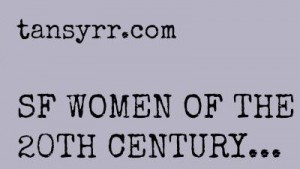 SF WOMEN OF THE 20TH CENTURY is brought to you by Tansy’s supporters at Patreon.
SF WOMEN OF THE 20TH CENTURY is brought to you by Tansy’s supporters at Patreon.
Patrons of the blog can earn great rewards and help the campaign reach exciting milestones to unlock more content.
1. Raccoona Sheldon & “The Screwfly Solution”
2. Diane Marchant & Kirk/Spock
3. Connie Willis & To Say Nothing of the Dog
4. Clare Winger Harris & “The Fate of the Poseidonia”
5. Octavia E. Butler & Dawn
6. Wendy Froud & Yoda
7. C.L. Moore & “No Woman Born”
8. Robin Klein & Halfway Across the Galaxy and Turn Left
9. Joanna Russ & To Write Like A Woman
10. Lois McMaster Bujold & Cordelia’s Honor
11. Naoko Takeuchi & Sailor Moon
12. Leigh Brackett & The Sword of Rhiannon
Thea Von Harbou & Metropolis [SF Women of the 20th Century]

Metropolis, the 1927 silent German expressionist film often held up as the first great science fiction movie (and currently viewable on Netflix) is generally credited as director Fritz Lang’s Metropolis, which was why I was so intrigued to discover the involvement (and extended career) of Thea Von Harbou, Lang’s wife and co-writer on the project.
Thea Von Harbou, a Bavarian aristocrat and child prodigy, was an active screenwriter, filmmaker, actress and novelist in Berlin between the first and second World Wars. She was married to Lang between 1922 and 1933.
Von Harbou’s writing technique often involved writing a novel and screenplay simultaneously or concurrently, so that the novel could be released at the same time as the film’s release – this was the case with Metropolis, in which she wrote the novel first (it was published in 1925 as a serial in the magazine Illustriertes Blatt well ahead of the film’s release, and then in novel form in 1926) but always intended the novel to promote the book rather than vice versa. Indeed, the serialised edition of the story was illustrated with set pictures of the film-in-progress. The intention was very much for the novel and the film to work in sympathy with each other, so that those confused by the film (given the limitations of how complex a story you could tell in the silent movie era) could get a deeper idea of the plot from the book – in the case of Metropolis the book became an essential tool for understanding the film after it was cut, re-edited and redistributed in later years, thanks to Lang’s unhappiness with the original version.
the super creepy original novel cover, featuring a still from the film
A great many magical and occult references were dropped from the screenplay (or, perhaps, expanded upon in the novel, as supernatural themes were of great interest to Von Harbou and often turned up in her work), though the film of Metropolis still holds a great deal of mythic and Biblical resonance, along with some quite extraordinary visual imagery.Metropolis depicts a future world where an elite aristocracy enjoy immense privilege, and a dehumanised underclass suffer as their workforce inside a factory system – near-literal cogs in a cruel machine. The film does not approve of this system – a great deal of the story is about demonstrating the unfairness of it – and yet it does not fully condemn/overthrow it either. The themes of man versus machine (and particularly, human workforce who are both treated as if they are machines, and ultimately replaced by machines) are highly relevant today – possibly even more so than when the film was released. The creation of a robot leads to a Frankenstein-style narrative, of a highly dangerous creation creating chaos, the main difference being that the central inhuman figure of Metropolis is female.
 Thea Von Harbou’s later work was often overtly nationalistic, with a focus on morale-boosting and sacrifice in the name of patriotism. She trod a careful and often uncomfortable political line as the Nazi Party took control of the state – several of her films of the era are overtly pro-Nazi, while she was also known to work (often uncredited) on other projects which were socialist in nature.
Thea Von Harbou’s later work was often overtly nationalistic, with a focus on morale-boosting and sacrifice in the name of patriotism. She trod a careful and often uncomfortable political line as the Nazi Party took control of the state – several of her films of the era are overtly pro-Nazi, while she was also known to work (often uncredited) on other projects which were socialist in nature.
Von Harbou herself later claimed that she officially joined the Nazi Party to help support Indian immigrants like the man she married after Lang, Ayi Tendulkar (whom she had to marry in secret because Nazi policies at the time). Other sources suggest she was enthusastic in her support of the new regime. It’s very likely that the question mark over her political alignment is a big reason why Von Harbou’s role in this iconic film is often played down.
Fritz Lang was distressed that Metropolis – an epic fairy tale of man and machine – was enjoyed/approved of by prominent Nazi leaders such as Goebbels, and said that he detested the film once it was finished:
“The main thesis was Mrs. Von Harbou’s, but I am at least 50 percent responsible because I did it. I was not so politically minded in those days as I am now. You cannot make a social-conscious picture in which you say that the intermediary between the hand and the brain is the heart. I mean, that’s a fairy tale – definitely. But I was very interested in machines.”
Metropolis stands as an integral piece of genre history and one worth considering and examining for its rich visual beauty as well as its themes. The physical depiction of a female automaton is particularly interesting, and the art deco design. It’s also totally on Netflix, so you can see for yourself whether it feels like a story of protest or of conformity and compromise in the face of injustice.
HG Wells, who is also cited as one of the influences of the film, wrote a scathing review of the film: “foolishness, cliché, platitude, and muddlement about mechanical progress and progress in general.” He deeply disapproved of the premise of the film – that is, the idea that automation creates drudgery rather than relieving it. 90 years later, in a world revolving around technology, I’m not sure that his point holds up.
Roger Ebert said of the film: “Metropolis is one of the great achievements of the silent era, a work so audacious in its vision and so angry in its message that it is, if anything, more powerful today than when it was made.”
 SF WOMEN OF THE 20TH CENTURY is brought to you by Tansy’s supporters at Patreon.
SF WOMEN OF THE 20TH CENTURY is brought to you by Tansy’s supporters at Patreon.
Patrons of the blog can earn great rewards and help the campaign reach exciting milestones to unlock more content.
1. Raccoona Sheldon & “The Screwfly Solution”
2. Diane Marchant & Kirk/Spock
3. Connie Willis & To Say Nothing of the Dog
4. Clare Winger Harris & “The Fate of the Poseidonia”
5. Octavia E. Butler & Dawn
6. Wendy Froud & Yoda
7. C.L. Moore & “No Woman Born”
8. Robin Klein & Halfway Across the Galaxy and Turn Left
9. Joanna Russ & To Write Like A Woman
10. Lois McMaster Bujold & Cordelia’s Honor
11. Naoko Takeuchi & Sailor Moon
12. Leigh Brackett & The Sword of Rhiannon
December 14, 2015
Issue #1: Spider-Woman (2015)
Writer: Dennis Hopeless
Artist: Javier Rodriguez
The Buzz: All I knew about this going in was the cover art with a massively pregnant Jessica Drew looking cheerful. Pregnant superheroes ahoy!
All You Need To Know: The Spider-verse has been pretty damn active over the last couple of years, and I’ve barely got a handle on any of it. Jessica Drew is a former Avenger, SHIELD agent and spy… and now she’s pregnant. This is her maternity leave.
Story: Unlike the Spider-Woman series that launched last year, this one is a genuine number 1! It introduces the characters and set up without you feeling like you’ve missed a bunch – or at least, you have missed a bunch, but that’s because there’s been a time skip, so everyone has too!
Jessica is heavily pregnant, and has not revealed the father to anyone including close friend Carol Danvers. She’s been spending her pregnancy training up a Porcupine-themed replacement for her superheroics, with the help of Daily Planet reporter Ben Urich.
This is a fun, character-rich first issue which shows Jessica’s frustrations at the limitations of pregnancy, and her immense boredom at the concept of maternity leave… until, of course, something happens to make it a lot more interesting!
I can’t tell you how much I want a comic with a pregnant superhero fighting aliens possibly in space to be a thing that exists in the world. This is the most I have liked Jessica Drew (who I always wanted to like but she kept turning into like Skrulls and things) ever.
Art: Fun, colourful and sharp. I really like this style, especially the interpretations of Captain Marvel, Jessica herself, and even some of the cameo appearances at her maternity leave party, like Tony Start and Clint Barton. (After New Avengers & All-New Hawkeye it’s kind of a relief to see a Clint who looks like a regular person instead of a steroid-case again!)
But What Did I Miss?: Eh, some stuff, I’m sure they’ll explain it as we go. ISSUE 1!
Would Read Issue 2?: Absolutely.
Read it if you Like: Captain Marvel, Ms Marvel, Squirrel Girl, Black Canary, Batgirl
Previously reviewed this year:
Thor #1 (2014)
Spider-Woman #1 (2014)
All-New Captain America #1 (2014)
Captain America & the Mighty Avengers #1 (2014)
S.H.I.E.L.D. #1 (2014)
The Unbeatable Squirrel Girl #1 (2015)
Bitch Planet #1 (2014)
Secret Six #1 (2014)
Operation: S.I.N. #1
Spider-Gwen #1
Curb Stomp #1
Jem & the Holograms #1
Silk #1
Issue #1 – Convergence Special – Oracle, JLI, Batgirl
Issue #1 – Battleworld Special: Lady Kate, Ms America & Inferno
X-Men ’92 #1
Giant-Sized Little Marvels: AvX #1 (2015)
Runaways #1 (2015)
Loki, Agent of Asgard #1 (2014)
Fresh Romance #1
All-New Hawkeye #1
Black Canary #1
The Wicked and the Divine #1 (2014)
Bombshells #1
Captain Marvel & the Carol Corps #1
50 Years of SHIELD: Mockingbird #1
50 Years of SHIELD: (Don’t Call Her…) The Cavalry #1
50 Years of SHIELD: Quake #1
50 Years of SHIELD: Fury #1
50 Years of SHIELD: Agent Carter #1
New Avengers #1 (2015)
Totally Awesome Hulk #1
All-New Hawkeye #1
December 12, 2015
Get Your Cape On! (at Super Hero High)
Hippolyta let out a big sigh—the one that mothers reserve for their children when they have so much to say but can’t get it all out.“My dearest daughter,” she said, her voice softening. “You were born to be a leader. You have royalty in your blood. Stay here, and someday you will rule Paradise Island and be Queen of the Amazons, just like me.”
Now it was time for Wonder Woman to be silent. She breathed deeply before saying, “Mother, I love and admire you. But when I grow up, I want to be just like me.”
[excerpt from Wonder Woman At Super Hero High, by Lisa Yee, coming in 2016]
One of my pet rants over the ten eleven years that I have been a mother is the exclusion of women (as characters and audience) from superhero merchandise – and other toys like LEGO which have been traditionally marketed only to boys.
The main reason this is a problem? Kids play with toys, and the toys available to them shape the games they play and the way they see the world. At a time when the superhero concept is at an all time marketing high, it’s a problem that girls have been shown that they don’t get to be superheroes. It’s an equal and overlapping problem that boys have been shown that girls aren’t worthy of being superheroes.
Let’s be clear here. Girls often gravitate towards traditionally girly stuff, and boys often gravitate towards traditionally boy-y stuff. Ask any parent who tried valiantly not to buy into all the gender bullshit, only to have their girl reach for baby dolls and princess dresses, while the toddler boys grabbed trucks and made their own rayguns out of play-doh. Kids liking traditionally gendered toys isn’t really the problem. The problem is their choices are narrowing – toys and other products marketed to children have become more and more binary in nature in recent years, so it’s all but impossible to find anything gender-neutral, or shared-gender products. For boys and girls who do want to cross over the pink and blue lines, the path gets harder all the time.
Kids might often choose the obvious-gendered option for themselves, but that doesn’t mean they shouldn’t be offered viable alternatives!
We’ve all seen the way that LEGO has struggled with this – shifting over the decades from a gender neutral toy that siblings could play with together, to a super-macho building universe that excluded women so dramatically that the only way they could imagine change (and sell toys to girls again) was to invent a separate super-girly building universe two aisles away.
The kids aren’t the ones telling us that they only want to play with characters of their own gender. Even the TV shows they watch and books they read are (mostly) not telling them that – except those that are based on existing toy lines.
My daughters have grown up alongside my friend’s sons, as honorary siblings/cousins, with overlapping interests – LEGO, Harry Potter, Doctor Who superheroes. I still remember a 6 year old Raeli telling me earnestly that the reason she loved the Tiny Titans comic was because it wasn’t girly or boy-y – it was about kids all together.
Smart (and interested, and engaged) kids notice when you take a fun concept like “superhero team”, and leave out all the women. Smart kids get just as outraged as their mother when they hear that a fantastic show like Young Justice got cancelled because the audience was “too female.” Smart kids notice that Black Widow and Scarlet Witch get left off the Avengers merch, and that it’s really hard to get hold of a Wonder Woman action figure, and that the large majority of ‘Early Reader’ superhero books are about male characters.
Also, primary school age kids who think romance and kissing is super gross really really REALLY notice when the single action figure of a female character they can find has her catsuit unzipped, or a tiny waist bent over to make her boobs look bigger. Pre-teen boys and girls alike aren’t all that keen on action figures that look like porn stars. Which, sadly, cuts down their options considerably.
[just look at the argument about slave Leia toys in recent weeks – um, yes, it’s authentic to the movie, but what does it say about our culture that the most commonly reproduced outfit for the original female hero of Star Wars is the only super gross sexist one, as opposed to all the other outfits she wears while doing her job? The message this sends to girls is obvious, but what about the awful message it sends to boys about the place of women in the universe? Toys that don’t require a corresponding lecture about the patriarchy are the best toys]
My younger daughter Jem (6) is much more gender essentialist and girl-centric in the way she sees the world than Raeli (10+) – she’s hung on to the pretty frockitude longer than her elder sister did, and takes a perverse glee in enjoying the ‘super girly’ toys and shows that her elder sister loathes. Yes, I do let her watch the Bratz cartoon. I don’t like it, but you have to respect a kid who uses pop culture to one-up a sister four and a half years her senior. Jem also enjoyes Monster High, Ever After High (kind of Once Upon a Time for tweens), Barbie in the Dreamhouse (surprisingly clever and subversive) and that terrifying thing where the My Little Pony characters got turned into horsey high schoolers.
Jem also adores superheroes. She has invented her own Wonder Woman spin off character, she clings to the rare examples of girl-centred superhero books I’ve managed to acquire, and she taught herself to punch by watching Ana in Frozen. She requested a superhero birthday party – I made her a Black Widow cake – and she adores the new Supergirl TV show.
All of which is a roundabout way of saying that my Jem is a prime candidate for the new DC girl merch initiative, DC Super Hero Girls. She’s been hanging out for this. Sure, she’s into the shows full of cute girly girl characters who are Best Friends Forever and maybe have magic or really great fashion sense. But add to that some training montages, capes and saving the universe, and Jem is 100% on board.
Like LEGO Friends (which has a lot of benefits and a lot of problems in its execution though I can’t deny it’s been a commercial success) DC Super Hero Girls is a cross-media project, designing a group of characters to appeal to the young female demographic and rolling them out across vids, books, toys, games, etc. The really cool thing about it is the way that they have been actively looking at creating change in the way girl toys are presented, and listening to feminist advocates (and actualy children) about what they want from a female super hero range.
DC Comics has, like Marvel, decades and decades of story fuel to draw on. The range of female characters across DC history, while their execution has at times been problematic, is vast and has been presented excellently to kids before via animated series like Justice League Unlimited, Teen Titans Go, and Young Justice. But even when the shows have had great female characters, the toys and associated merch have often not bothered to reflect that.
So now we have DC Super Hero Girls – or at least, we will. The website currently hosts a couple of games, character profiles, and some fun vids (animations by Warner Bros) based around the adventures that the girls have at school. I especially like that the school is made up of ‘hero’ and ‘villain’ characters from the comics, but they’re all currently being treated as potential heroes, including Harley Quinn, Poison Ivy, Star Sapphire and Killer Frost. I love that Batgirl’s computer skills are being emphasised, that Amanda “the Wall” Waller is the principal, and I even love that boys are included though not centred in the stories. The videos aren’t quite as dynamic and adorable as the short-lived Super Best Friends Forever that we fell in love with a few years ago, but there are more of them, the voice acting has some happy surprises, and they are getting more interesting as they go along.
Right now on the website you can download the first three chapters of the new Wonder Woman chapter book that will be released next year, by Lisa Yee – it looks great, and Jem is already champing at the bit for it. And while the character designs still present a team of very pretty, slender girl heroes (more bodily diversity would be good), I appreciate the strong body language, and emphasis on musculature and athleticism rather than prettiness and fashion plate skills.
These sporty heroes-in-training look positively healthy compared to the grotesquerie of the Monster High/Ever After High designs, and the dolls seem much less likely to snap at the knee than the spindly fashion ghouls.
The Mary Sue went into some detail a while back about the thinking and the research that went into designing the DC Super Hero Girls:
Researchers found that girls didn’t want the superheroes to be too girly, a problem with the first round of dolls that Mattel developed. One girl complained that the toys looked “more pretty than superhero,” and another pointed out that Poison Ivy’s scarf would only get in the way during a fight. Wonder Woman, meanwhile, was too skinny and not athletic enough.
Kim, the toy designer, instructed her team to use gymnasts, dancers, and basketball players as primers for sculpting more muscular versions of the dolls and action figures.
The design team, by the way, were women. Which explains the flat soles, sensible shoes, and confident stance of the dolls.
At a time when even Barbie’s most common profession is princess, it’s really nice to see a breath of change coming, for those girls whose power fantasies incorporate more ideas than sparkle magic, fashion and shopping: they can play at all those things if they want, but from next year it will be easier for them to factor in training to save the world.
Back home, Wonder Woman leaned forward and studied the recruitment video. Super Hero High School was everything she had ever dreamed of. The school boasted an expansive campus with a gleaming high-rise in the center. It offered its students and faculty up-to-the-moment technology, gadgets, and weapons to die for. Plus there was the recently unveiled Flight Track and the much- used on-campus hospital. And the only thing more impressive than the inspirational statue of Justice herself in the courtyard was the iconic Amethyst from Gemworld that sat atop the school’s highest tower, piercing the clouds and doubling as a welcoming beacon for incoming flyers.
Oh! And there were classes taught by celebrity super-hero alumni, and more clubs than anyone could possibly have time for, like Playing with Poisons, Cooking with Swords, and the ever-popular Knitting and Hitting. But what Wonder Woman found most fascinating were the students.
Every kind of teenager imaginable was represented—some with multiple superpowers, and others with none at all. Many of the snootier schools, like Interstellar Magnet, only considered students based on their grades, superpowered test scores, and superpower pedigree. But Super Hero High had a loftier goal. Here, students
were selected not based on who they were today, but on who they could become tomorrow. Girls, boys, animals, insects, aliens, robots, mutants, morphers—they were all in the video. This was an equal-opportunity school, and it appealed to Wonder Woman’s keen sense of justice.
[excerpt from Wonder Woman At Super Hero High, by Lisa Yee, coming in 2016]
My daughters took the quiz on the website, and apparently I have a ten-year-old Harley Quinn and a six-year-old Poison Ivy on my hands. I am… not surprised, really.
December 10, 2015
Issue #1: All-New Hawkeye
Writer: Jeff Lemire
Artist: Ramon Perez
The Buzz: None really? After the epic last run of Hawkeye, the new team got 5 issues to play with before Battleworld/Secret Wars shook everything up – the story was fine, with many elements in common with its predecessor, though it had a weird ending. Now it gets a second relaunch for the year…
All You Need To Know: Kate and Clint are fighting because of a previous mission where they had to rescue some scared test subject kids, who turned out to be super dangerous. Clint came to terms with giving up the kids before Kate was and she’s pissed off about it…
Story: Ugh, you know what, I think I’m done. I love Team Hawkeye completely, but this so called #1 just continues the same argument they were having before Secret Wars, and it’s getting painful now. I wanted to like this title, didn’t want it to go downhill after the previous creative team left, but it’s like they picked up on three panels from the Fraction-Aja-Wu epic and decided that Clint and Kate’s characters are all about that one time they had a massive blow up, and not all the other cool teamwork and shared sense of humour stuff. Basically in this, Clint and Kate fight about the last mission, which was months ago and in a “different” comic, indispersed with a future storyline where cranky old Kate and Old Man Barton haven’t been talking for fifteen years, which means this is the longest fight in the Marvel Universe and also apparently she’s dating Noh-Varr in the future. I can’t escape the feeling that this writer hates Kate Bishop, or wants her to hate herself.
Art: The shift in palette between time lines is clever enough, but I’m finding the character work unattractive and samey. This comic makes me sad.
But What Did I Miss?: So there’s this great Hawkeye comic which went for 22 issues, written by Matt Fraction with art by David Aja and Annie Wu? In all seriousness, as with (I suspect) many post Secret Wars titles, this is not an Issue #1, it’s Issue #6 of a series that really should have been something special by now, and is instead kind of sad and humourless.
Would Read Issue 2?: Not right now. Too depressed. Maybe later on Marvel Unlimited, to give it one more chance for redemption.
Read it if you Like: hating Hawkeye.

